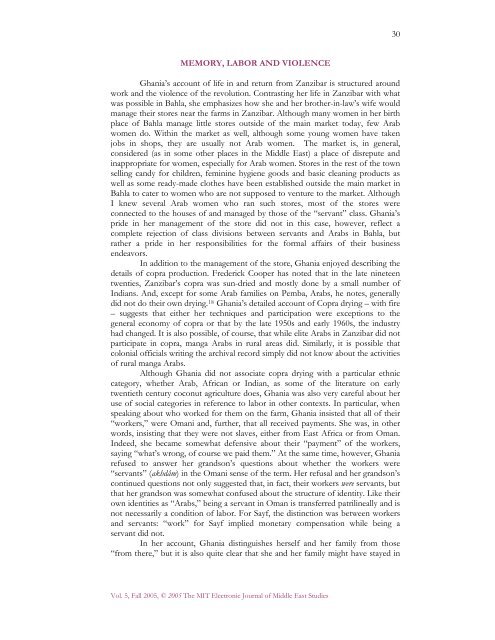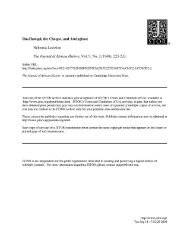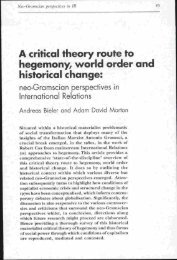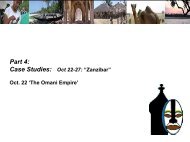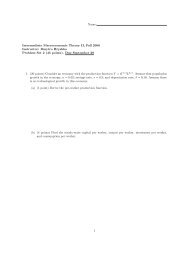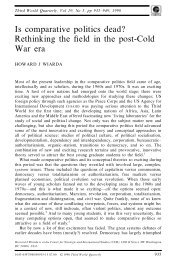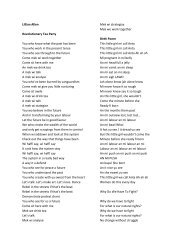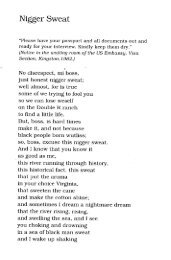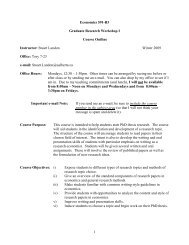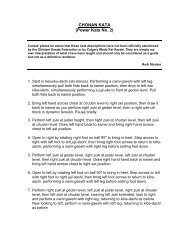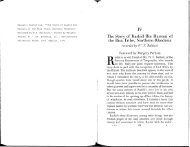personal memories revolutionary states and indian ocean migrations
personal memories revolutionary states and indian ocean migrations
personal memories revolutionary states and indian ocean migrations
Create successful ePaper yourself
Turn your PDF publications into a flip-book with our unique Google optimized e-Paper software.
MEMORY, LABOR AND VIOLENCE<br />
Ghania’s account of life in <strong>and</strong> return from Zanzibar is structured around<br />
work <strong>and</strong> the violence of the revolution. Contrasting her life in Zanzibar with what<br />
was possible in Bahla, she emphasizes how she <strong>and</strong> her brother-in-law’s wife would<br />
manage their stores near the farms in Zanzibar. Although many women in her birth<br />
place of Bahla manage little stores outside of the main market today, few Arab<br />
women do. Within the market as well, although some young women have taken<br />
jobs in shops, they are usually not Arab women. The market is, in general,<br />
considered (as in some other places in the Middle East) a place of disrepute <strong>and</strong><br />
inappropriate for women, especially for Arab women. Stores in the rest of the town<br />
selling c<strong>and</strong>y for children, feminine hygiene goods <strong>and</strong> basic cleaning products as<br />
well as some ready-made clothes have been established outside the main market in<br />
Bahla to cater to women who are not supposed to venture to the market. Although<br />
I knew several Arab women who ran such stores, most of the stores were<br />
connected to the houses of <strong>and</strong> managed by those of the “servant” class. Ghania’s<br />
pride in her management of the store did not in this case, however, reflect a<br />
complete rejection of class divisions between servants <strong>and</strong> Arabs in Bahla, but<br />
rather a pride in her responsibilities for the formal affairs of their business<br />
endeavors.<br />
In addition to the management of the store, Ghania enjoyed describing the<br />
details of copra production. Frederick Cooper has noted that in the late nineteen<br />
twenties, Zanzibar’s copra was sun-dried <strong>and</strong> mostly done by a small number of<br />
Indians. And, except for some Arab families on Pemba, Arabs, he notes, generally<br />
did not do their own drying. 18 Ghania’s detailed account of Copra drying – with fire<br />
– suggests that either her techniques <strong>and</strong> participation were exceptions to the<br />
general economy of copra or that by the late 1950s <strong>and</strong> early 1960s, the industry<br />
had changed. It is also possible, of course, that while elite Arabs in Zanzibar did not<br />
participate in copra, manga Arabs in rural areas did. Similarly, it is possible that<br />
colonial officials writing the archival record simply did not know about the activities<br />
of rural manga Arabs.<br />
Although Ghania did not associate copra drying with a particular ethnic<br />
category, whether Arab, African or Indian, as some of the literature on early<br />
twentieth century coconut agriculture does, Ghania was also very careful about her<br />
use of social categories in reference to labor in other contexts. In particular, when<br />
speaking about who worked for them on the farm, Ghania insisted that all of their<br />
“workers,” were Omani <strong>and</strong>, further, that all received payments. She was, in other<br />
words, insisting that they were not slaves, either from East Africa or from Oman.<br />
Indeed, she became somewhat defensive about their “payment” of the workers,<br />
saying “what’s wrong, of course we paid them.” At the same time, however, Ghania<br />
refused to answer her gr<strong>and</strong>son’s questions about whether the workers were<br />
“servants” (akhdâm) in the Omani sense of the term. Her refusal <strong>and</strong> her gr<strong>and</strong>son’s<br />
continued questions not only suggested that, in fact, their workers were servants, but<br />
that her gr<strong>and</strong>son was somewhat confused about the structure of identity. Like their<br />
own identities as “Arabs,” being a servant in Oman is transferred patrilineally <strong>and</strong> is<br />
not necessarily a condition of labor. For Sayf, the distinction was between workers<br />
<strong>and</strong> servants: “work” for Sayf implied monetary compensation while being a<br />
servant did not.<br />
In her account, Ghania distinguishes herself <strong>and</strong> her family from those<br />
“from there,” but it is also quite clear that she <strong>and</strong> her family might have stayed in<br />
Vol. 5, Fall 2005, © 2005 The MIT Electronic Journal of Middle East Studies<br />
30


